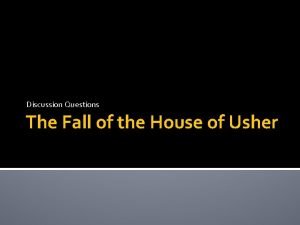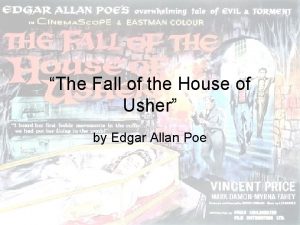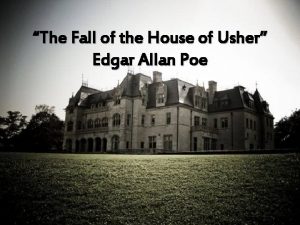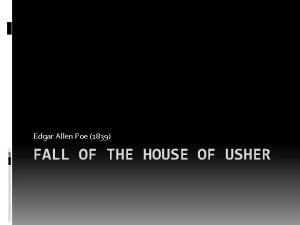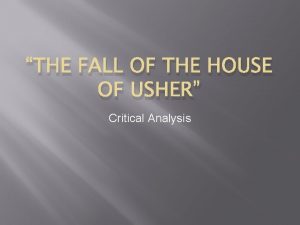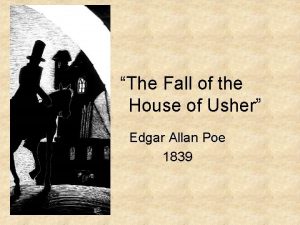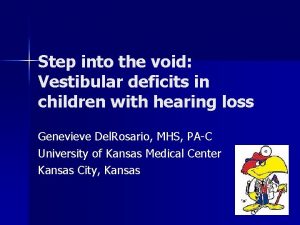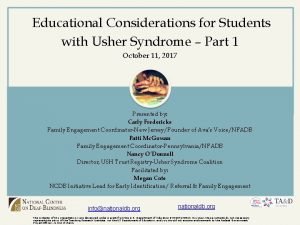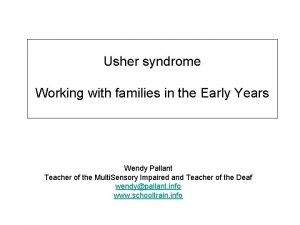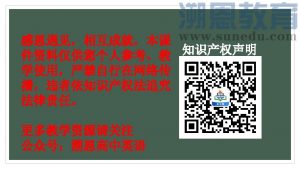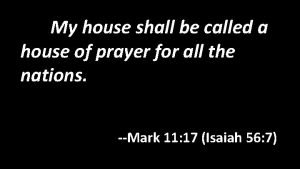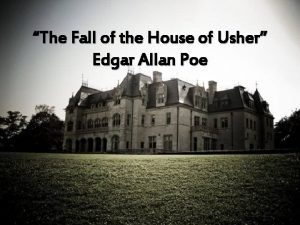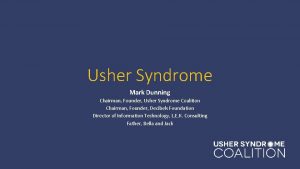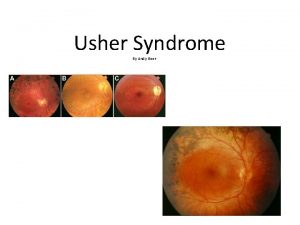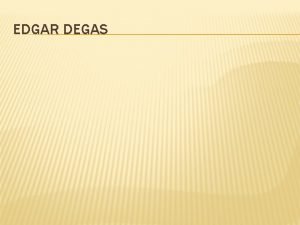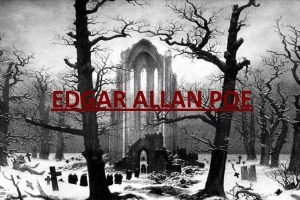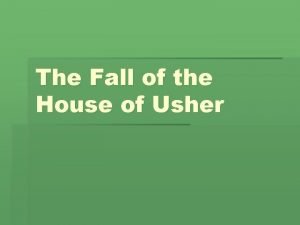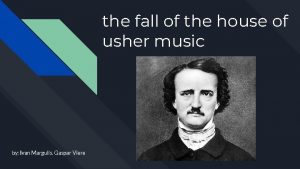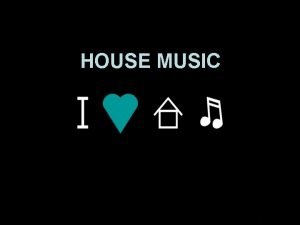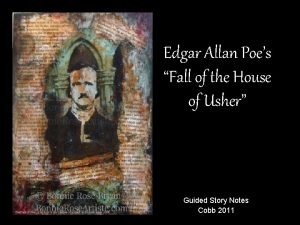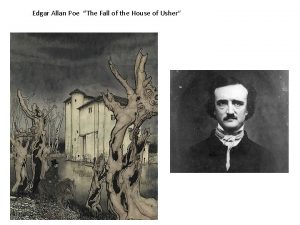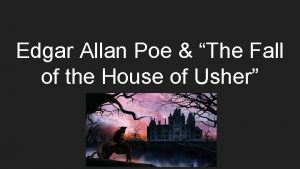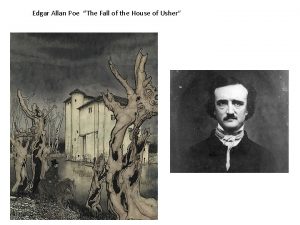The Fall of the House of Usher Edgar






















- Slides: 22

“The Fall of the House of Usher” Edgar Allan Poe 1839

“The Fall of the House of Usher” • • The gothic context of the tale The doubling motif of the tale The function of setting in the tale The structural unity of the tale

The Gothic literary tradition • Begun in eighteenth century England • Novelists – Horace Walpole – Ann Radcliffe – Matthew “Monk” Lewis • Popular form in British literary journals • Imported into American short story - 19 th century • Key ingredient was sensationalism

Gothic Architecture in America • Started in US about 1840 • Steeply pitched roofs • Pointed arch windows • Elaborate trim around roof edges • High dormers • Lancet windows

• Poe’s “house of Usher” looks more like a medieval castle or English cathedral in Gothic style

• The house might look something like this (from a photograph by Simon Marsden in his Visions of Poe)

Elements of Gothic Writing • Emphasis on setting – Exterior: landscape – Interior: houses • • Castle-like architecture Characters are brooding, secretive Buried family secrets Long history of family tied to place

The Doubling Motif • In literary criticism, this is called a “doppelganger, ” from the German for “double-goer” • Examples are: – Dr. Jekyll and Mr. Hyde (Robert Louis Stevenson) – The Secret Sharer (Joseph Conrad)

What function does the doppelganger motif serve? • Represents the dual nature of man – In Poe, one side of man is reason, or the mind – The other is emotion, or the body • Roderick and Madeleine are genetically twins, but psychologically they are also doubles.

Who Represents What? • Roderick – An artist figure (509) – Nervous agitation (509) – Lives in dark upstairs apartment (511) – Cadaverous complexion (511) – “want of moral energy” (511) – “excessive nervous agitation” (511 -12)

• Roderick’s mental condition is affected by his environment • “He was enchanted by certain superstitious impressions in regard to the dwelling which he tenanted. . . An effect which the physique of the gray walls and turrets, and of the dim tarn into which they all looked down, had, at length, brought about upon the morale of his existence. ” (512)

• Here, “physique” refers to something physical • And “morale” refers to something mental • Roderick is all mind in a weak body • He represents in one way the life of the isolated artist – Paintings – Reading – Guitar playing

• Madeleine – Illness has debilitated her – All descriptions focus on the body – “gradual wasting away of the person” (513) – Roderick and the narrator screw down the lid of her coffin (518) – She returns from the tomb to reclaim her twin brother, her “double” – “the huge antique panels…threw back” (521) – She “fell heavily inward upon…her brother and…bore him to the floor a corpse”

What is Poe’s point? • Poe addresses the dual and conflicted nature of the Self • Mind and body are at war with each other in each of us • We try to repress one side and live without it • But we cannot achieve a harmonious existence in this way

The Function of Setting Exterior • The “house of Usher” has two meanings 1. The physical dwelling 2. The family line, or lineage 1. “the entire family lay in the direct line of descent”

• The house is also a type of character in the story – Like the family, it is of “an excessive antiquity” (510) – The landscape is overgrown and ragged – On the front down the middle is “a barely perceptible fissure” going in “a zigzag direction” (510)

Interior Setting • Gothic architecture (511) – “windows were long, narrow and pointed” – “feeble gleams of encrimsoned light” – “dark draperies” – “atmosphere of sorrow” • Roderick lives upstairs (mind) • Madeleine is entombed below ground (body)

Structure and Unity • Poe creates texts within texts 1. “The Haunted Palace” (poem) reflects the Usher family life in the house (515) 2. “The Mad Trist” (story) parallels Madeleine’s return from the grave 3. The storm outside is analogous to the turmoil inside the characters in the house 4. The book titles in Roderick’s library are symbolic of themes of the story

Roderick’s Library • “the Chiromancy of Robert Flud, of Jean D’Indagine” • “the Directorium Inquisitorum” • “old African Satyrs, over which Usher would sit dreaming for hours” (516 -17)

Poe’s Theory of Literary Unity • Poe earned his living as a “magazinist, ” not a fiction writer. • He was an editor and reviewer for many major magazines. • Poe wrote a great deal of literary criticism, literary theory, and book reviews. • His theory of literary unity was articulated in a review of Hawthorne’s collection of stories, Twice-Told Tales in 1842

• An author should “conceive, with deliberate care, a certain unique or single effect to be wrought out, [and] then invent such … events as may best aid him in establishing this preconceived effect. • In the whole composition there should be no word written, of which the tendency, direct or indirect, is not to the one pre-established design.

Unity in “Fall of the House of Usher” • First and last paragraphs are mirror images of each other, creating symmetry • The texts-within-text reinforce the central theme • The house itself symbolizes the split in the family • The construction of the house reflects a “perfect adaptation of parts” (510)
 Which descriptive details of the interior of the house
Which descriptive details of the interior of the house The fall of the house of usher crack quote
The fall of the house of usher crack quote The fall of the house of usher theme
The fall of the house of usher theme The fall of the house of usher pre reading activities
The fall of the house of usher pre reading activities Ambiguity in the fall of the house of usher
Ambiguity in the fall of the house of usher Gothic elements in the fall of the house of usher
Gothic elements in the fall of the house of usher Signos vitales recien nacido
Signos vitales recien nacido Usher syndrome
Usher syndrome Usher interview
Usher interview Usher kids ages
Usher kids ages Gallaudet university
Gallaudet university Banished boarding house vs house
Banished boarding house vs house They went house to house
They went house to house My house shall be called a house of prayer
My house shall be called a house of prayer Dfhi in money market
Dfhi in money market Branded house house of brands
Branded house house of brands St vincents housing association
St vincents housing association Voi kéo gỗ như thế nào
Voi kéo gỗ như thế nào Thiếu nhi thế giới liên hoan
Thiếu nhi thế giới liên hoan Fecboak
Fecboak điện thế nghỉ
điện thế nghỉ Một số thể thơ truyền thống
Một số thể thơ truyền thống Thế nào là hệ số cao nhất
Thế nào là hệ số cao nhất
